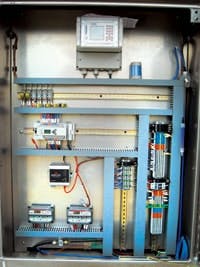Fourteen seconds.
That is certainly not the type of performance one wants from an automobile going from zero to 60. For a wireless radio system gathering data from more than 70 sites spanning 85 sq miles at extremely varied terrain levels, however, 14 seconds is the crème de le crème of performance.
The geographical representation is that of the Padre Dam Municipal Water District (MWD), located in Eastern San Diego County, Calif., which serves several communities from Santee to Alpine. Its terrain ranges from 100 to 2,600 ft in elevation.
Upgrading Technology
Padre Dam MWD decided to go wireless with ProSoft Technology Industrial Hotspot radios in mid-2010 because it was becoming difficult to maintain its former system.
The district’s old system, which used RS-232, had a maximum baud rate of 4,800 and took 90 seconds to collect data from all sites.
“The software to drive the original radio system was a custom program written in ‘C Programmable’ by outside contractors. The original authors of the program were no longer available,” said Rich Mellor, Padre Dam MWD SCADA technician. “There was a great desire to replace the system with one that could be installed and maintained with in-house staff, eliminating dependence on outside contractors.”
Between the difficulty of maintaining the old system and its speed of response, Padre Dam officials knew it was time to upgrade. After a path study was performed with relatively few issues, installation and configuration of then new radios went smoothly.
“Along with the radios, we replaced the entire remote terminal unit (RTU), including new MicroLogix 1400 programmable automation
controllers, power supplies, terminal blocks and wiring,” Mellor said.
The terrain also posed some challenges.
“There are many natural and man-made difficulties, which made line of sight an almost impossibility, even though some of our sites are on the highest points around the county,” Mellor said. “Using some ingenuity and the radios’ repeater ability, we were able to use some of the 900-MHz radios as repeaters, allowing us to pass information through very difficult terrain.”
ProSoft’s wireless engineers came on site for two days to assist Padre Dam officials with the field study and verify connectivity. After the study, Prosoft helped the district evolve the system by creating “backbone” communications using its 2.4-GHz radios.
Nine radios linked in a circular pattern allowed communications in either direction should a failure of one radio ever occur. Seven of the nine 2.4-GHz radios are positioned at key sites around the district working with the local 900-MHz radio and programmable logic controllers (PLC) to transfer the gathered RTU data back to the office at high speeds. The final two radios are at the office collecting data and storing it in a ControlLogix PLC.
There is no AC power at some of Padre Dam’s remote locations, but there is solar power.
“This was a learning curve, between the size of the panels and the type of batteries,” Mellor said. “Parabolic antenna mounting also became an issue due to size, angle needed, mounting them back to back and providing a weatherproof splitter to tie them into a single radio.”
A Balancing Act
The wireless radios were phased in over time. The final radio was installed in mid-2012.
“We had to be careful not to interrupt operations too much,” Mellor said. “Water delivery and storage is a balancing act between demand and weather.”
Data from 70 sites in 14 seconds allows Padre Dam MWD to respond immediately should one of its RTUs shut down, much like what happened in April 2012.
“A person driving near one of our RTUs lost control, hit a hydrant and completely destroyed our RTU. Within a just a few seconds, the human machine interface recorded an alarm of low pressure and total loss of communications with that site,” Mellor said.
Learning what happened and where the incident took place was quick and easy with the new system in place.
Download: Here


